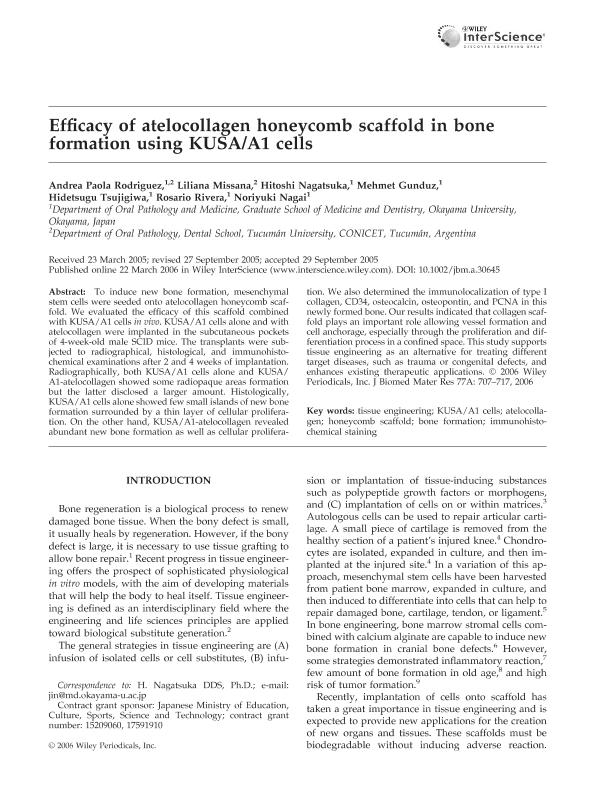Artículo
Efficacy of atelocollagen honeycomb scaffold in bone formation using KUSA/A1 cells
Rodriguez, Andrea Paola ; Missana, Liliana Raquel
; Missana, Liliana Raquel ; Nagatsuka, Hitoshi; Gunduz, Mehmet; Hidetsugu Tsujigiwa,; Rivera, Rosario; Nagai, Noriyuki
; Nagatsuka, Hitoshi; Gunduz, Mehmet; Hidetsugu Tsujigiwa,; Rivera, Rosario; Nagai, Noriyuki
 ; Missana, Liliana Raquel
; Missana, Liliana Raquel ; Nagatsuka, Hitoshi; Gunduz, Mehmet; Hidetsugu Tsujigiwa,; Rivera, Rosario; Nagai, Noriyuki
; Nagatsuka, Hitoshi; Gunduz, Mehmet; Hidetsugu Tsujigiwa,; Rivera, Rosario; Nagai, Noriyuki
Fecha de publicación:
12/2006
Editorial:
Wisley InterScience
Revista:
Journal Of Biomedical Materials Research
ISSN:
0021-9304
Idioma:
Inglés
Tipo de recurso:
Artículo publicado
Clasificación temática:
Resumen
To induce new bone formation, mesenchymal stem cells were seeded onto atelocollagen honeycomb scaffold. We evaluated the efficacy of this scaffold combined with KUSA/A1 cells in vivo. KUSA/A1 cells alone and with atelocollagen were implanted in the subcutaneous pockets of 4-week-old male SCID mice. The transplants were subjected to radiographical, histological, and immunohistochemical examinations after 2 and 4 weeks of implantation. Radiographically, both KUSA/A1 cells alone and KUSA/ A1-atelocollagen showed some radiopaque areas formation but the latter disclosed a larger amount. Histologically, KUSA/A1 cells alone showed few small islands of new bone formation surrounded by a thin layer of cellular proliferation. On the other hand, KUSA/A1-atelocollagen revealed abundant new bone formation as well as cellular proliferation. We also determined the immunolocalization of type I collagen, CD34, osteocalcin, osteopontin, and PCNA in this newly formed bone. Our results indicated that collagen scaffold plays an important role allowing vessel formation and cell anchorage, especially through the proliferation and differentiation process in a confined space. This study supports tissue engineering as an alternative for treating different target diseases, such as trauma or congenital defects, and enhances existing therapeutic applications
Archivos asociados
Licencia
Identificadores
Colecciones
Articulos(CCT - NOA SUR)
Articulos de CTRO.CIENTIFICO TECNOL.CONICET - NOA SUR
Articulos de CTRO.CIENTIFICO TECNOL.CONICET - NOA SUR
Citación
Rodriguez, Andrea Paola; Missana, Liliana Raquel; Nagatsuka, Hitoshi; Gunduz, Mehmet; Hidetsugu Tsujigiwa,; et al.; Efficacy of atelocollagen honeycomb scaffold in bone formation using KUSA/A1 cells; Wisley InterScience; Journal Of Biomedical Materials Research; 77; 4; 12-2006; 707-717
Compartir
Altmétricas



